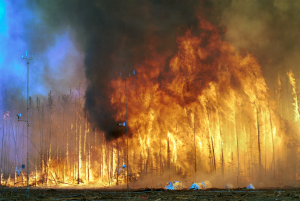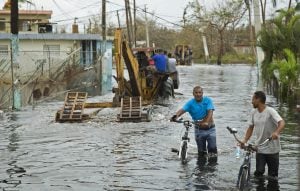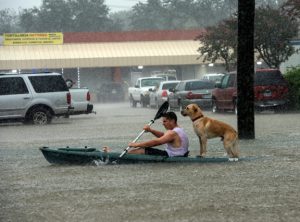This summer has seen multitude of extreme weather events. Wildfires have raged in the United States, Sweden, and the United Kingdom, and Japan declared a state of emergency due to unprecedented high temperatures.
The extreme heat follows the extreme cold experienced by many countries over the winter. Scientists point to climate change as a factor increasing the risk of both trends. Over the winter, temperatures in the Arctic were around 20 degrees Celsius above normal, pushing colder air toward Europe.
Meanwhile, this summer’s heatwaves in Europe have been made twice as likely due to climate change. This was the preliminary assessment by researchers at the World Weather Attribution network, which comprises scientists from six institutions worldwide who provide near-real time analysis of links between climate change and extreme weather.
Then there is the flooding and hurricanes that dominated the headlines only last summer. The WMA judged that the extreme rainfall over Houston, Texas in the US during hurricane Harvey in 2017 was roughly three times more likely, and 15% more intense, due to climate change.
Failing to adapt
The case for adaptation grows stronger and more urgent with each of these weather events. Yet action is not prioritised or coordinated across government departments and sectors, experts say.
“In many countries and communities, climate change is discussed only within the ministry or department of environment, which limits their ability to better manage an issue that affects many different aspects of peoples’ lives,” says Rebecca Carter, deputy director of climate resilience practice at the World Resources Institute (WRI).
More frequent and severe heatwaves can strain electricity systems, reduce water supplies, overwhelm healthcare facilities, affect transportation and impact agriculture, she points out. Each of these sectors needs to have plans in place to deal with emergencies, and infrastructure investments must take climate adaptation into account, she adds.
In the UK, a parliamentary committee inquiry into the country’s preparedness for heatwaves published its report last week. It found that climate adaptation was not adequately coordinated, and had fallen through gaps between departments. It recommended that a minister be put in charge to increase collaboration.
Countries need to recognise that the impacts they are beginning to experience now are only the start
The same goes for developing countries. Achala Abeysinghe, principal researcher on climate change at the International Institute for Environment and Development (IIED), says that political commitment is a must for the least developed countries, where the ability to adapt to climate change is critical to their survival.
“Departments need to work together and be coordinated from the national to community level. This is key for shaping country policy, programme planning and channelling of funds,” she says.
In addition, climate adaptation needs to be viewed over long time frames, and countries need to recognise that the impacts they are beginning to experience now are only the start, Carter says.
“Longer-term planning for intensifying climate impacts can have significant implications for the way essential resources such as land and water are used, as well as for investment decisions. For example, while sea level rise has so far been fairly minor in most areas, recognising that this will change in the not-too-distant future could lead to better decisions to build key infrastructure such as new roads, schools and hospitals in areas unlikely to be flooded during severe storms,” she says.
Financing gap
Of course, all of this adaptation costs money. The least developed countries are not only the most vulnerable, but also the least to blame for climate change, and the least able to pay the cost. Finance has been pledged through international channels but is far short of what is needed. It also does not necessarily reach the right people, Abeysinghe says.
“Climate finance needs to reach where it has the highest impact and this can be done effectively when the communities are involved. Local people are in the best position to know what needs to be done to protect their lives and livelihoods from the impacts of climate change,” she says.
Too much money is either just sitting in funds or promised for big infrastructure projects
IIED has found that less than one in ten dollars of climate finance is allocated for the purpose of reaching vulnerable communities. “Too much money is either just sitting in funds or promised for big infrastructure projects that take decades to deliver. It is vital that this crucial money is channelled to where it will matter most,” Abeysinghe says.
The involvement of communities has also been highlighted in Africa, with the knowledge of indigenous peoples in particular a focus of a recent meeting of policymakers, scientists and meteorologists organised through UNESCO, according to Xinhua.
“Africa's steady development agenda has been put at risk with the advent of climate change. We should therefore understand how our diverse systems of traditional knowledge can be harnessed to boost climate response,” Ann Therese Ndong-Jatta, director of UNESCO East African Regional Office says.
Lawyers have issued a warning to governments and businesses who fail to act. Sophie Marjanac, a lawyer at campaigning firm ClientEarth says: “If decision-makers continue to stand still on climate change, they can be sure that scientific improvements will spur on future climate change cases as people seek to attribute responsibility for the devastating consequences of extreme weather events.”







![Interview with Badi community members in Ramaghat village, Dailekh [image by: Diana Suhardiman]](https://dialogue.earth/content/uploads/2018/08/1.interview-in-Badi-300x225.jpg)
